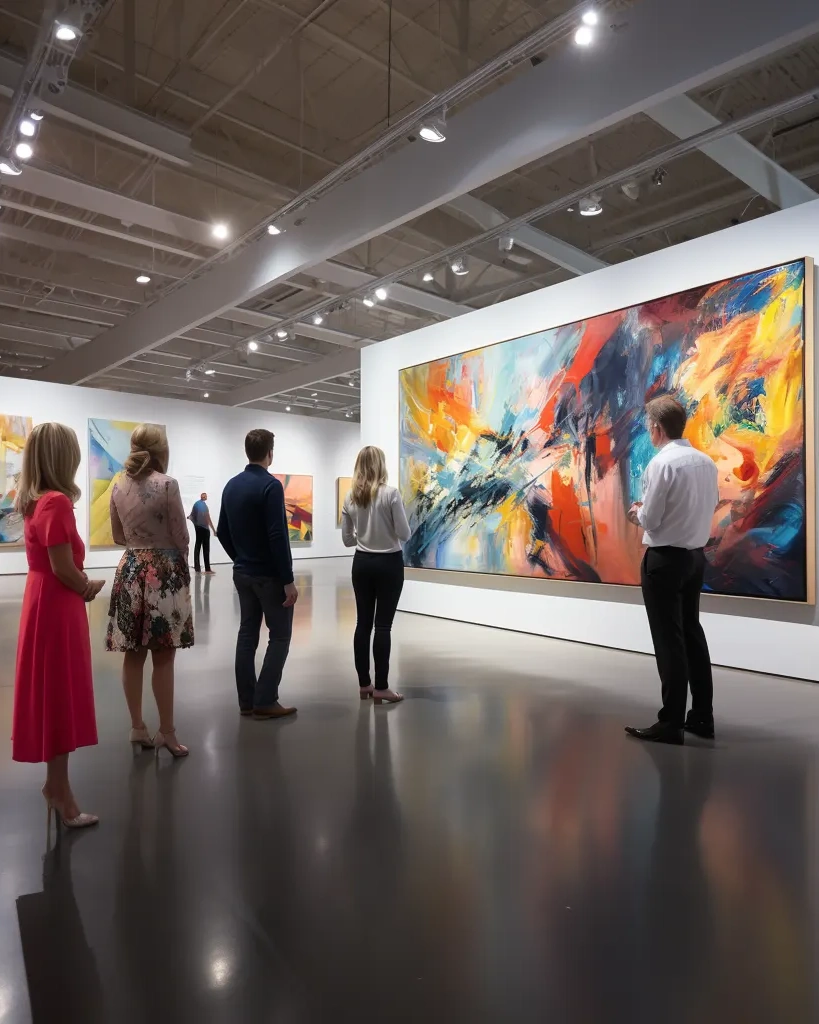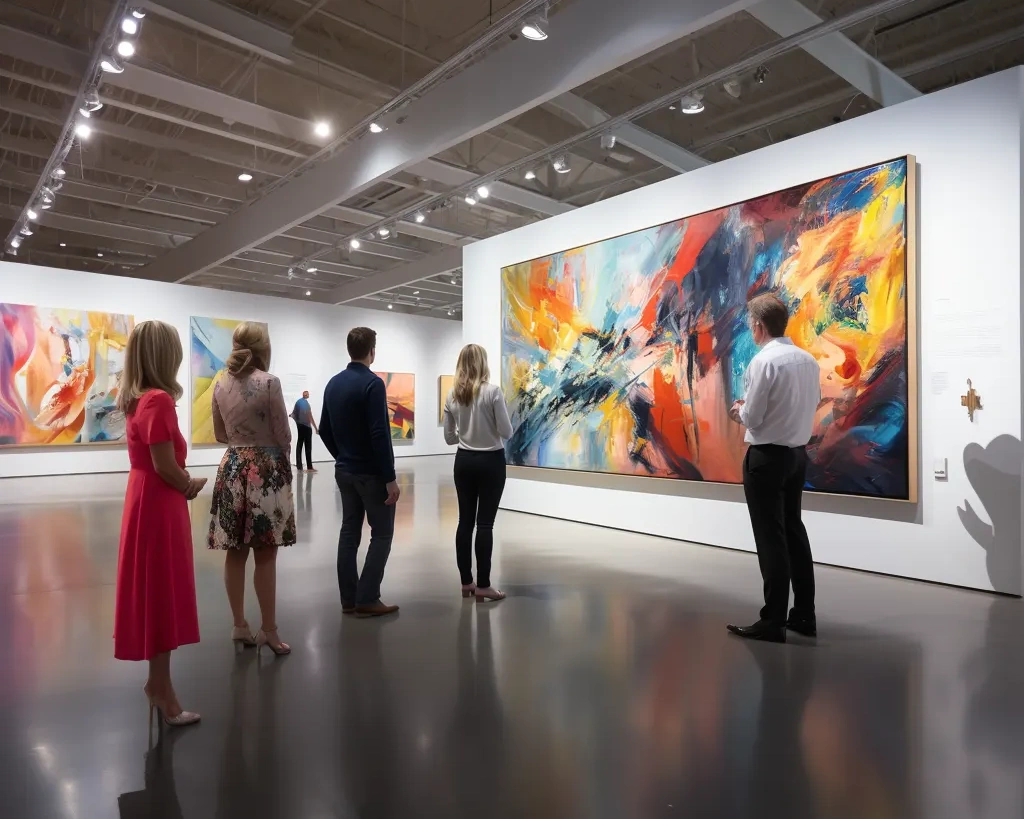Art investment guide: The Ultimate Guide to Starting Your Art Investment Journey


Investing in art can be a great way to diversify your portfolio and potentially earn a profit, but it can also be overwhelming for those new to the field. Here are some tips to help you get started:
Educate yourself
Educate yourself: Read books, attend events, and visit museums and galleries to familiarize yourself with different styles and artists.
When it comes to investing in art, education is key. Start by reading books, attending events, and visiting museums and galleries to familiarize yourself with different styles and artists. This will give you a better understanding of the art world and the various genres that exist.
Additionally, you can attend art fairs and exhibitions, which can provide a great opportunity to view works by established artists as well as up-and-coming talent. It is also important to understand the market and the history of art.
This can be done by researching past sales and auction results, as well as keeping up to date with current market trends and news. Talking to experts in the field can also be incredibly helpful in gaining a better understanding of the market and the potential of specific artists or pieces. Remember, the more you educate yourself, the better equipped you will be to make informed investment decisions.
Determine your budget
Consider how much you’re willing to spend on a piece and stick to that budget. Remember, there are many affordable options available for new collectors.
When it comes to investing in art, it’s crucial to determine your budget beforehand. This will help you avoid overspending and ensure that you are able to stick to your financial goals.
Consider how much you’re willing to spend on a piece and make sure to stick to that budget. Keep in mind that while high-priced works by famous artists may seem like a safe bet, there are also many affordable options available for new collectors. You can find quality works by lesser-known artists or up-and-coming talent, which can provide great value for your investment.
Don’t be afraid to look for opportunities to buy works at a discount, such as at an auction or from a gallery during a slow period. The key is to find a balance between budget and quality, so that you can make informed investment decisions while also staying within your financial means.
Work with a reputable dealer
Working with a reputable dealer is essential when investing in art. Look for dealers who have a good reputation in the art world and have a solid track record of selling quality works. This will help you avoid scams and ensure that you are buying authentic pieces. A reputable dealer will have a deep knowledge of the market and can provide valuable insights into the value of specific works and artists.
We are proud to work with one of the top companies in London when it comes to investing in art. Our partner has a proven track record of success, having sold millions in art over the years. They are experts in their field and can help you navigate the complex world of art investment with ease. Whether you’re looking to buy a specific piece or build a collection, our partner can provide guidance and support every step of the way. By working with a reputable dealer like our partner in London, you can invest in art with confidence and potentially earn a profit while also adding to your collection.
Consider your personal taste
When investing in art, it’s important to consider your personal taste. Invest in pieces that you truly love and appreciate, as this will make the process more enjoyable and you will be more likely to hold onto the work for the long term. Collecting art can be a deeply personal experience, and you want to make sure that you are buying works that resonate with you and your values. Whether you’re drawn to abstract works, contemporaryContemporary, mirroring the German notion of "Zeitgenosse" -... More pieces, or classical masterpieces, make sure to follow your instincts and choose pieces that speak to you.
In addition to enjoying the works in your collection, investing in pieces that you love can also increase their emotional value and sentimental worth, which can make them more valuable over time. The key is to find a balance between investing in works that have strong potential for appreciation, and works that bring you personal joy and fulfillment. This way, you can build a collection that is not only a solid investment but also a reflection of your tastes and interests. Remember, investing in art is not just about making a financial return, it’s also about building a meaningful collection that brings you joy and satisfaction.
Do your research
Doing your research is critical when investing in art. Take the time to study the market, understand the history of specific artists and genres, and learn about the value of different pieces. You can attend exhibitions and fairs, read books and articles, and consult with experts to gain a deeper understanding of the art world.
It’s also important to research the reputation and track record of the dealers and galleries you are considering working with. Make sure to ask for references, read reviews, and thoroughly vet the authenticity of any pieces you’re interested in purchasing.
At our company, we understand the importance of research in the art investment process. That’s why we offer full assistance to our clients to help them make informed decisions. Our team of experts has a deep knowledge of the market and can provide valuable insights and advice. Whether you’re just starting to build your collection or looking to add to an existing one, we can help you every step of the way. With our assistance, you can have peace of mind knowing that your investments are backed by thorough research and expert knowledge. Connect with us today to learn more about how we can help you navigate the world of art investment with confidence.
Buy at the right time
Timing is key when it comes to investing in art. Understanding when to buy and sell can have a significant impact on the return on your investment. Keep an eye on market trends, follow the latest news and exhibitions, and pay attention to changes in the overall economy, as these can all influence the value of specific artists and works.
It’s also important to consider the artist’s career trajectory when deciding when to buy. Works by emerging artists can be a great opportunity to invest at a lower price point, while established artists often see their works appreciate over time. Look for artists who are making a name for themselves and have a solid body of work, as these are the ones most likely to experience growth in the future.
Additionally, it’s essential to be mindful of the art market cycle. Like any other market, the art world experiences periods of growth and contraction, so timing your purchases and sales can have a significant impact on your overall return. A knowledgeable art dealer or advisor can help you understand the market trends and provide guidance on when to buy and sell.
In short, buying art at the right time requires a combination of market knowledge and personal instincts. With the right information and a bit of patience, you can make informed investment decisions and potentially earn a profit while also building a meaningful collection.
Get insurance and proper storage
Get insurance and proper storage: Protect your investment by getting insurance coverage for your art and storing it in a safe and secure location.
By following these steps, you can start investing in art with confidence and potentially earn a profit while also adding to your collection. Remember, art investment is a long-term commitment, so be patient and enjoy the process.
In conclusion
In conclusion, investing in art can be a rewarding experience that combines the joy of collecting with the potential for financial returns. By educating yourself, determining your budget, working with a reputable dealer, considering your personal taste, doing your research, and buying at the right time, you can invest in art with confidence and potentially build a valuable collection.
Remember, investing in art is a process that takes time and research. But with the right approach, you can make informed decisions and build a collection that brings you both joy and financial benefits.
If you need any assistance along the way, our team of experts is here to help. Whether you have questions about the process, need guidance on specific pieces, or simply want to discuss your goals, we are here for you. Contact us today to learn more about how we can help you navigate the world of art investment with ease.